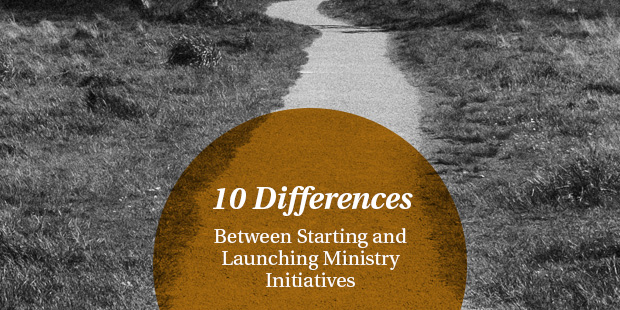The number of failed church plants in the Denver area over the past decade is staggering. Depending on which organization you talk to the number is dozens to hundreds. Hundreds of thousands of dollars, untold man hours and many lives invested in churches that no longer exist. Since moving here last year I’ve been asking every church planter, church plant leader and pastor I meet why they think so many planters fail in the Mile High City. After countless chai lattes, white chocolate mochas and orange cranberry scones I am beginning see some patterns emerge. Maybe this list will be helpful in your life or your community as you or your church consider entering the world of church planting.
Why do church plants fail?
1) Unqualified leaders
“Certain good men appeal to me who are distinguished by enormous passion and zeal, and a conspicuous absence of brains; brethren who would talk forever and ever upon nothing – who would stamp and thump the Bible, and get nothing out of it at all; earnest, awfully earnest, mountains in labor of the most painful kind; but nothing comes of it all…therefore I have usually declined their applications”
Charles Spurgeon (Quoted by Tim Keller in Center Church)Despite the abundance of church planter assessments and training there are still a lot of people attempting to plant churches who aren’t cut out for the task. For some it is a lack of leadership ability, for some it is a lack of the requisite gifts of a church planter and for some it is lack of entrepreneurial experience. Success as a youth pastor doesn’t necessarily equate to success in starting a church from scratch. The harsh reality is there are a lot of people trying to plant churches who would better serve the Kingdom coming alongside another leader.
2) Lack of understanding or respect of the local context
Understanding: Reading demographic reports, subscribing to the local paper, and chatting with a barista at Starbucks doesn’t prepare a transplant for the unique context of a city. There is no substitute for extended time living in the culture to understand the culture. I think it is significant that Jesus lived in Galilee for 30 years before he began his ministry.Making the context even more difficult to grasp are the vast differences from neighborhood to neighborhood in a typical city. There is no such thing as a Denver culture; Boulder and Parker might as well be on different planets, Washington Park and Highlands have almost nothing in common, and Stapleton has a completely different vibe than Thornton. The only way to begin to understand the difference between Lakewood and Littleton is to rent a condo off Sante Fe and hang out at Merle’s on Main Street.
Respect: A local leader who has seen many church planters come and go over the past 15 years told me one of the biggest mistakes is a lack of respect for the local context. Planters move from another part of the country and unconsciously try to turn Denver into a version of their home town. They see a casual attitude, fierce independence and commitment to the outdoors as obstacles to be overcome rather than a culture to embrace. They believe deeply that once people are exposed to authentic worship and true Gospel preaching they will cancel their season lift tickets and skip Broncos games to join a small group and faithfully attend Sunday services. Sadly when this doesn’t happen they are disillusioned and soon move back home.
3) Underfunded
Church planting is an expensive business. It will usually take longer and cost more than planned for, and this catches many planters by surprise. It doesn’t matter what model you use, it takes money to survive.Many planters have tried to plant in Denver using missional communities thinking it is cheaper than the traditional launch large model espoused by Rick Warren, Nelson Searcy and others. While they don’t have to purchase a monster sound system, a massive trailer and incredible children’s ministry equipment, what they often fail to account for is how little money 30 people in a missional community give. Missional church planters often find themselves working a full-time job to feed their family and leading missional communities in their spare time. Growing a vibrant, self-supporting church from a missional community base is incredibly difficult and slow. Many planters run out of energy and money before the new church can thrive.Not only is the launch large model expensive upfront, but the costs just keep coming even after the equipment is purchased and the mailers are sent. The Overhead Monster (payroll, rent, insurance, supplies, equipment repair) eats 24 hours a day, seven days a week. Services cancelled because of a snow storm? Feed the Monster. Offering drops by half because the Broncos have a 11:00 a.m kickoff? Feed the Monster. Trailer and all the equipment stolen and insurance won’t pay? Feed the Monster. Feed the Monster. Feed the Monster.While piles of cash don’t guarantee a church plant will survive and thrive, lack of funding eventually dooms many church plants. You can’t raise too much money.
4) Rigid model
Church planters often arrive in Denver with a fully formed model in mind; they have been to NorthPoint, Elevation or New Spring, they’ve read a book by Stanley, Searcy or Stetzer, they plan to copy the church they came from or they plan to do the opposite of the church they came from. They have a catchy name, a splashy website and a three-ring binder full of mission, vision and values. And then they encounter Denver. It turns out nine other church plants have the same catchy name, unchurched people aren’t compelled by their compelling environments, and its hard to turn a Crowd into a Core when the entire crowd shares a last name with the planter. All of the work they did at church planter boot camp seems wasted.The military maxim, “No battle plan survives contact with the enemy” applies to church planters. The planters who survive and thrive are able to adapt, modify or scrap their pre-determined model as they begin to understand their context. The planters who fail tend to be more in love with their model than the people their model is intended to reach.
5) Planting alone
One of the enduring legends of church planting is Rick and Kay Warren driving from Texas to Orange County, California with nothing but a U-Haul, a real estate agent and a call from God. From that meager beginning Rick planted what became Saddleback Church, one of the most influential churches on the planet. Many, many church planters have followed in Rick’s footsteps, moving their family across the country to plant a church in a city where they don’t know a soul. What is often missed in the legend is that Rick grew up in California. He preached evangelistic rallies up and down the California coast while attending college at California Baptist University, 40 miles from the Saddleback Valley. Rick was not a good ole boy from the south coming to save a foreign people, he was a California boy returning home after a couple of years in seminary. While the church did begin with Rick, Kay and their real estate agent, they were able to draw on existing connections with other churches and leaders in the area.Church planting is a lonely business and every planter needs a team. A great indicator of future success is the ability to bring a team along on the mission. While there are challenges when a pre-existing tight knit group tries to start a church in a new community, it is much better than the alternative. The Lone Ranger parachute drop into a new town makes the path to a thriving church incredibly difficult.
6) Resiliency
“Everyone has a plan until they are punched in the face” Mike Tyson
The one common factor in every church plant is getting punched in the face. It may be a best friend who decides to move back home, a key family who transfers to the local mega church so their kids can attend a better youth program, or discovering the worship leader is sleeping with a band member to whom they are not married. For me it was the three biggest tithing families representing over 25% of the annual budget quitting the church in a two-week period. I’ve yet to meet a church planter who hasn’t experienced a gut-wrenching, circumstantial punch to the face, often repeatedly. Some leaders get up from the canvas and stay in the match; many leaders count the cost and decide that it is just too difficult to continue to fight.Getting punched in the face again and again and again isn’t necessarily the right decision. Many times the pain is so great, the cost so enormous that the only reasonable choice is to throw in the towel. This doesn’t mean the leader is weak or wrong, it simply means the match is over and the church closes. The church plants that survive and thrive are led by leaders who are able take the punches and get up from the canvas again and again. In many cases the only reason a church plant is still alive is because the leader doesn’t have the sense to quit.One question many church plant leaders in Denver ask a potential planter is, “If the church doesn’t make it, are you going to stay in Colorado? Are you in love with our community or are you in love with church planting?” This is a really tough question, but it speaks to resiliency. Many planters are gone when the money runs out, while others get part-time jobs, change models, change locations, join with another church, do anything it takes to continue to be a part of what God is up to on the Front Range of Colorado because the burden is so deep they can’t imagine living anywhere else.
7) Intangibles
Calling: Does the leader have a clear calling from God to plant a new church in this community? Wanting to do church a new way, a desire to start something new, or a passion to lead fall short of motivation to survive and thrive in a tough environment.Tough soil: Jesus said that the Gospel is planted in all kinds of soil and yields wildly different results. There are places in Colorado (Boulder) that are as receptive as a concrete slab to the Word. There is a romanticism to “planting in the toughest place on earth”, but there is also a need for sober judgement. Jesus said there are some towns that simply won’t receive the Gospel.
Luke 10:8 –Luke 10:11 (ESV) Whenever you enter a town and they receive you, eat what is set before you. Heal the sick in it and say to them, ‘The kingdom of God has come near to you.’ But whenever you enter a town and they do not receive you, go into its streets and say, ‘Even the dust of your town that clings to our feet we wipe off against you. Nevertheless know this, that the kingdom of God has come near.’
Timing: Some successful church plants are just in the right place at the right time. A subdivision is built, a freeway off ramp opens, or a local church splits and suddenly the church planter is teaching workshops on the right way to plant a church while negotiating a book deal. Any church plant that grows from 0-400 overnight has likely hit the mother lode of timing.
Unmerited favor: God blesses who and where he chooses . There are many examples of thriving churches who missed on almost every criteria I’ve mentioned in these posts and there are churches with everything going for them that didn’t make it. At the end of the day success in the Kingdom is determined by the unmerited favor of God.
Why do you think church plants fail in your community?

Tags: Church Plant, Fail, Geoff Surratt, local context, respect, understanding, unqualified leaders
|
What is MyVisionRoom? > | Back to Leadership >





























